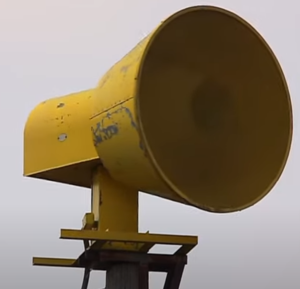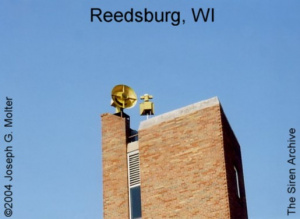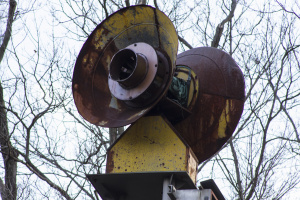500 Series: Difference between revisions
No edit summary |
TheCamWheel (talk | contribs) mNo edit summary |
||
| (29 intermediate revisions by 4 users not shown) | |||
| Line 1: | Line 1: | ||
{{Infobox siren | {{Infobox siren | ||
|image = [[File: | |image=[[File:500.png|thumb|A Federal 500SH-TT located in Abilene, KS]] | ||
|company= [[Federal Signal Corporation]] | |company= [[Federal Signal Corporation]] | ||
|produced=1953-1982 | |produced=1953-1982 | ||
|type=[[Electromechanical]] | |type=[[Electromechanical]] | ||
|phase=1 or 3 | |phase=1 or 3 | ||
|voltage=120, 220, 240, or 480 | |voltage=120, 220, 240, or 480 | ||
|neigh=10 | |neigh=10-20 | ||
|output=123-130 | |output=123-130 | ||
|succeeded=[[RSH-10]] | |succeeded= [[508]], [[2001SRN]], & [[RSH-10]] | ||
}} | }} | ||
The 500 Series was a line of [[electromechanical]] sirens produced by [[Federal Signal Corporation|Federal Sign & Signal]]. | The 500 Series was a line of [[electromechanical]] sirens produced by [[Federal Signal Corporation|Federal Sign & Signal]]. | ||
It went through a lot of prototyping, ranging from a coded unit that allows it to make a "pulsed" signal, along with variants of single and dual tone models, even different phase motors were tested. They finally settled on one design that was compact, yet effective. This model unfortunately was advertised as a "mid-range" siren by Federal, which in turn caused their [[Thunderbolt]] siren to outsell it by a long shot | It went through a lot of prototyping, ranging from a coded unit that allows it to make a "pulsed" signal, along with variants of single and dual tone models, even different phase motors were tested. They finally settled on one design that was compact, yet effective. This model unfortunately was advertised as a "mid-range" siren by Federal, which in turn caused their [[Thunderbolt]] siren to outsell it by a long shot. | ||
The 500 had 3 such models throughout its lifespan, the 500SH, 500SH-TT, and the 500DH-TT. SH stands for Single Head, TT stands for Two Tone, and DH stands for Dual Head. | |||
==Earlier Models== | |||
[[File:Reedsburg2 wi.jpg|thumb|left|A 500-SH with the support bars.]] | |||
The earlier 500, mostly seen around Los Angeles, have a shorter projector unlike the later ones, they were offered in 9/12 port, 12 port, and more rarer 8 port. Some models had support bars inside the projector to mitigate warping. Some models used the STH-10 chopper and stator and had a larger horn. | |||
==500-DHTT== | ==500-DHTT== | ||
[[File:Example.jpg|thumb|right|A 500-DHTT with parts missing.]] | |||
The 500-DHTT is a dual horn variant of the 500, they were offered with a 15 or 20 horsepower motor. In 1957 they increased the length of the rotator shaft, giving the siren head more clearance of the rotator body. They were produced as late as 1965-67. | |||
Roughly 100 were ever made, and 7 units are known to exist as of 2022. | |||
=== Details === | |||
The projectors are a two piece construction held together by rivets, it is attached to a sheet metal ring located on the stator by rivets and bolts. This ring also has a corrugated section for the motor cover to be held on by machine screws. The motor cover is fastened to the pedestal by 4 bolts, two on each side. The entire siren weighs about 1,250 pounds. | |||
==Media== | |||
* {{Link-inline-video |link=9iWDtVkUaKg |name= 10/12 500-SHTT in Dundee, Michigan}} | |||
* {{Link-inline-video |link=E5JUx3hclIc|name= 9/12 500AT in Bristol, Tennessee}} | |||
* {{Link-inline-video |link=nTlIOqlD9rI|name= 12 port 500-SH in Stewartsville, Missouri}} | |||
* {{Link-inline-video |link=FNBG35QF3QU |name= 500-DHTT in Calhan, Colorado}} | |||
[[Category:Sirens]][[Category:Rotating Sirens]][[Category:Electromechanical Sirens]][[Category:Single Toned Sirens]][[Category:Dual Toned Sirens]][[Category:Federal Signal Corporation]] | [[Category:Sirens]][[Category:Rotating Sirens]][[Category:Electromechanical Sirens]][[Category:Single Toned Sirens]][[Category:Dual Toned Sirens]][[Category:Federal Signal Corporation]] | ||
Latest revision as of 08:17, 29 March 2024
| 500 Series | |
 | |
| Company | Federal Signal Corporation |
|---|---|
| Produced | 1953-1982 |
| Type | Electromechanical |
| Sound output | 123-130 dBc at 100 feet |
| Horsepower | 10-20 |
| Voltage | 120, 220, 240, or 480V |
| Succeeded by | 508, 2001SRN, & RSH-10 |
The 500 Series was a line of electromechanical sirens produced by Federal Sign & Signal.
It went through a lot of prototyping, ranging from a coded unit that allows it to make a "pulsed" signal, along with variants of single and dual tone models, even different phase motors were tested. They finally settled on one design that was compact, yet effective. This model unfortunately was advertised as a "mid-range" siren by Federal, which in turn caused their Thunderbolt siren to outsell it by a long shot.
The 500 had 3 such models throughout its lifespan, the 500SH, 500SH-TT, and the 500DH-TT. SH stands for Single Head, TT stands for Two Tone, and DH stands for Dual Head.
Earlier Models

The earlier 500, mostly seen around Los Angeles, have a shorter projector unlike the later ones, they were offered in 9/12 port, 12 port, and more rarer 8 port. Some models had support bars inside the projector to mitigate warping. Some models used the STH-10 chopper and stator and had a larger horn.
500-DHTT

The 500-DHTT is a dual horn variant of the 500, they were offered with a 15 or 20 horsepower motor. In 1957 they increased the length of the rotator shaft, giving the siren head more clearance of the rotator body. They were produced as late as 1965-67. Roughly 100 were ever made, and 7 units are known to exist as of 2022.
Details
The projectors are a two piece construction held together by rivets, it is attached to a sheet metal ring located on the stator by rivets and bolts. This ring also has a corrugated section for the motor cover to be held on by machine screws. The motor cover is fastened to the pedestal by 4 bolts, two on each side. The entire siren weighs about 1,250 pounds.